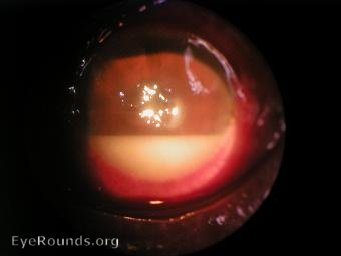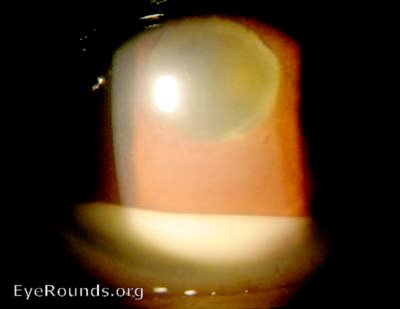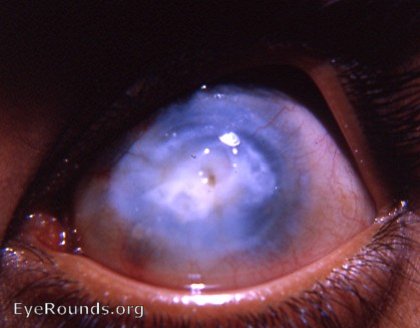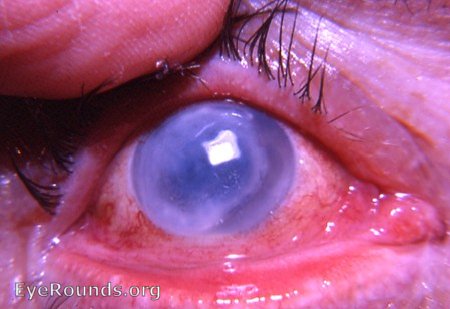Hypopyon
Contributor: Sunir Joshi, MSIII, Drexel University College of Medicine

Hypopyon from endogenous endophthalmitis
Contributor: Andrew Doan, MD, PhD, University of Iowa
Category: Uveitis

Leukoma from hypopyon ulcer
Contributor: William Charles Caccamise, Sr, MD, Retired Clinical Assistant Professor of Ophthalmology, University of Rochester School of Medicine and Dentistry
*Dr. Caccamise has very generously shared his images of patients taken while operating during the "eye season" in rural India as well as those from his private practice during the 1960's and 1970's. Many of his images are significant for their historical perspective and for techniques and conditions seen in settings in undeveloped areas.

This leukomatous cornea has a small central pigmented spot that represents the site of corneal perforation. There is also an irregularly bandshaped element to the keratopathy. An hypopyon ulcer was the basic cause of the existing corneal pathology.This type of case was seen daily at the Kurji Holy Family Hospital Eye Clinic 1951 - 1968.
Ulcus serpens / hypopyon ulcer / abscess of cornea

This type of ulcus serpens often developed as the smallpox patient appeared to be on the road to recovery. Not the smallpox virus but a secondary bacterial invader - frequently the pneumococcus bacterium - had taken advantage of a break in the corneal surface due to keratitis e lagopthalmo.
Hypopyon ulcer - initial stage

The photo shows the typical initial stage of an hypopyon ulcer in rural India. A young male laborer or farmer sustains a recognized or unrecognized injury to the cornea. The disruption in the epithelium is a portal for bacteria, e.g. pneumococci, and initiates the corneal ulcer seen in the photo. If not treated immediately with cycloplegics and antibiotic drops and ointment (while awaiting lab reports), the condition will produce a marked anterior segment inflammatory reaction with hypopyon. Perforation of the cornea with staphyloma or phthisis will follow. Properly and successfully treated, this ulcer will heal with a leucoma or a macular scar as the residuum.
Hypopyon ulcer / Ulcus serpens with hypopyon

In the past, smallpox was frequently accompanied by an hypopyon ulcer and all of that ulcer's horrendous complications. Now that smallpox has been virtually eliminated, trauma to the cornea with disruption of its epithelium is the commonest cause. The pneumoccocal organism is the most frequent causative invader. However, the diplobacillus of Morax-Axenfeld and the streptococcus bacillus can play a significant role in some cases.



Ophthalmic Atlas Images by EyeRounds.org, The University of Iowa are licensed under a Creative Commons Attribution-NonCommercial-NoDerivs 3.0 Unported License.


